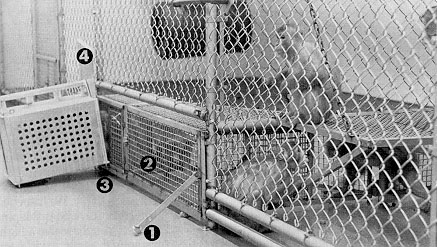By Viktor Reinhardt, D.V.M., Ph.D.
Primatologists periodically need to isolate a single rhesus monkey from its group. Such individual isolation is necessary for management procedures (like tuberculosis testing, weighing, or pregnancy examinations), medical procedures (injuries, diarrhea treatment, etc.), or research protocols (behavioral testing, blood sampling, or timed breeding, for example).
The two most common catching techniques entail chasing an individual monkey through a small opening into a transport box, or catching the individual monkey with a net. It takes little imagination to visualize the commotion and excitement associated with these procedures. Acute bouts of diarrhea are common in the caught monkey and its penmates. Such symptoms are unequivocal signs that the disturbed animals are experiencing stress. Is this necessary? At the Wisconsin Regional Primate Research Center, we have developed an alternative catching technique.
Capture Equipment
Each pen is composed of a large area and a small holding area. Wire mesh divides the two sections. There are two interconnections -a door opening into the large area, and a small passage close to the floor. One can control the opening and closing of the passage from the outside (Fig. 1, point #1). The passage is connected to a heavy-gauge mesh tunnel that exits into the large area (Fig. 1, point #2). One can also control the exit from the outside.
Close to the end of the tunnel is a third opening that leads to the outside of the pen (Fig. 1, point #3). This opening has a small sliding door and connects to a transport box with a guillotine door (Fig. 1, point #4). A panel, controllable from the outside, can divide the tunnel close to the sliding door.

Step-By-Step Animal Training
Step 1
Making sure the exit is closed, the attending animal caretaker chases the whole group of monkeys from the large area through the open door into the holding area. The caretaker then offers the monkeys favored food from the outside, and then releases them through the exit into the large area after about 30 minutes. The caretaker repeats this procedure on several different days.
The animals eventually become so well-conditioned that the caretaker can simply enter the room and clap his or her hands several times to get the group to move into the holding area quickly and without signs of excitation. The caretaker repeats this exercise on several occasions.
Step 2
Pushing aside the sliding door, the caretaker attaches a transport box with an open guillotine door to the third opening. The animals have free access to the holding area, the tunnel, and the transport box for about one week. The caretaker distributes favored food repeatedly at these locations.
Step 3
The caretaker confines the animals to the holding area. The passage and third opening are open and the exit is closed. Clapping hands, the animal caretaker gets several individuals to enter the tunnel. The caretaker then closes the passage and entices one of the trapped animals to enter the transport box. The caretaker closes the guillotine door, inserts the dividing panel and then carries the captured animal into a different room. After a few minutes, the caretaker returns the animal and releases it through the exit back into the large area where favored food is waiting as a reward for cooperation.
The caretaker catches and releases all other animals in the same way.
Step 4
The caretaker repeats Step 3 daily. The animals gradually start to enter the transport box one-by-one without special enticement. In time, the group enters the transport box in a specific order with each animal having a predictable rank position.
Step 5
The caretaker again confines the group in the holding area. The caretaker selects a specific animal. He or she then opens the passage and exit and releases all animals who have lower rank positions than the selected animal into the the large area.
The caretaker then closes the exit, opens the entrance to the transport box, and catches the selected animal as it follows the progression order. The caretaker catches each animal in this manner several times.
Step 6
Having trained all the animals, the caretaker catches each of them at least once every month. The caretaker performs all procedures involving manual handling (i.e. venipuncture, tuberculosis testing, and medical examination) in a separate room to avoid eliciting fear and aggression in the group.
We have successfully trained two heterogeneous rhesus troops of 28 and 33 members. The catching procedure has become a routine that is no longer associated with excitation and distress. It is now possible for one experienced person to catch animals at any given time (for example, on weekends if an animal is sick) without extra help.
Acknowledgments
The author is grateful to Richard Pape and Duane Zweifel for technical assistance in the design and manufacture of the capture equipment. Thanks are also due to John Wolf for proofreading the manuscript.
This investigation was supported by NIH grant RR00167 to the WRPRC.
Viktor Reinhardt is affiliated with the Wisconsin Regional Primate Research Center at the University of Wisconsin. Send reprint requests to the author at 1223 Capitol Court, Madison, W1 53715-1299.
Reprinted with permission of the publisher.
This article originally appeared in Lab Animal, volume 19, number 6.